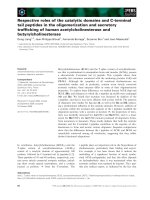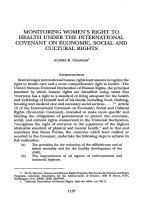HUMAN RIGHT and HUMINATARIAN RIGHT
Bạn đang xem bản rút gọn của tài liệu. Xem và tải ngay bản đầy đủ của tài liệu tại đây (74.44 KB, 7 trang )
Table of Contents
I.
International law.........................................................................................................1
I.
International human right laws....................................................................................2
II.
International Humanitarian law...................................................................................3
1
I.
International law.
The relationship of exchange and cooperation between countries is always
needed a legal corridor to ensure stability and durability. The work associated with
international law thus plays a key role in the era of globalization today. International
law is a system of principles and legal regulations, agreed by countries and other
entities of international law, on the basis of voluntariness and equality, to regulate
arising relations between countries and entities in all areas of international life (Hehir,
2017). Through struggle and negotiation. These laws are established to control
multifaceted relations (primarily political relations) among international legal actors
(first and foremost between nations) and in case of necessity, it is guaranteed to be
implemented coercively by the subjects of international law and by the struggle of the
people and public opinion in the world, countries come together to make these
agreements which are believed to be beneficial to their citizens (Kanrs and Mingst,
2004). International law enforces only when the sovereign state agrees to be bound, as
the result, state only agree when it convenient for them (Hehir, 2017). Federal
legislation is a system of legal, written or unwritten set of rules, it recognized by the
state to regulate legal relations between subjects of law, those relations arise from in
the territory or jurisdiction of that country. Domestic law has a direct effect on the
territory of the country that issued it. It governs the behavior and action of individuals
within its state or country. Different countries will have different legal systems.
When learning about any legal system, one of the most important issues that
we must approach is the "Source of Law". Rules of International Law come from
many different sources, the invocation and application of international law’s sources
has been defined by a specific chapter in the International Court of Justice: Item 1
Article 38 Chapter II (Kanrs and Mingst, 2004). Based on Article 38 we can see that
international law have 5 different types of sources: Treaties or conventions; customary
practices, writing of legal scholar, judicial decisions, general principles of law. Among
them, the two most important and fundamental sources are Treaties or conventions and
customary practices. Customary practices were formed in international relations
practice and recognized by international law subjects as a law. It is the process of
transforming from an informal law into a formal law. Thus, it is agreements that are
implicit and unwritten. Treaties are international legal documents agreed by countries
and other subjects of international law to establish, change or terminate the rights and
obligations between them, treaties can be universal or non-universal, global or
regional, multilateral or bilateral. An international treaty is a public agreement and is
expressed in writing form (Christopher, 2018). The United Nations, The International
Criminal Court, The International Court of Justice, The World Trade Organization are
the institutions of international law (Curtis and Jack 2011).
I.
International human right laws.
International human rights law is the body of international laws designed to
promote Human Right on social, regional and domestic level. The International
Human Rights Law is a collection of legal documents issued by intergovernmental
organizations, sovereign states represented by the United Nations, which regulates
human rights and guarantee to exercise those rights. Human rights have always been
one of the most important topics in the UN agenda. Recent regional and international
developments show that human rights issues will not only exist in the development of
humanitarian categories but also increasingly dominating legal relations, trade,
national sovereignty, international politics, peace and human civilization. There are
three roots of International Human rights Law: Religious Traditions which points out
some notes such as respect one another, prohibit the infliction of physical or mental
pain on others, help those in need, equality of race and racial toleration. The
Philosophers and Political Theorists includes the contents: State can neither usurp nor
undermine, individual are equal and autonomous beings whose natural rights predate
both national and international law, no individual should be deprived of life, liberty, or
property, without due process of law. The last one is Universalism and Cultural
Relativism which states that all Human rights are universal, indivisible and
interdependent and interrelated.
Related to the development history of human rights, it is possible to divide the
rights into three generations. The creator of this idea (in 1977) was a Czech jurist
named Karel Vasak (globalization101.org). The first generation is Political and civil
rights. According to Vasak, the first generation of human rights is directed at two main
issues: freedom and participation in the political life of individuals. This generation
includes the rights and freedom of people such as the right to live, the right to freedom
of religious belief, freedom of expression, the right to vote, to stand for election, the
right to have a fair trial. These rights are tied to the category of personal freedom. The
second generation of human rights is socio-economic, which aims at creating equal
and fair conditions and treatment for all citizens in society. They were strongly
promoted and mobilized since the end of the nineteenth century. Typical rights that
belong to this generation include: the right to be employed, the right to have social
protection and health care services, the right to own housing ... the third one is Human
right for specific group, this system includes typical rights of sell-determination,
development right, rights to natural resources, right to peace, right to a healthy
environment ... This list of generation rights is still being added, including the recently
mentioned rights including: communication rights, right to participation in cultural
heritage (globalization101.org). There are four divisions of Human right governance
process. The first is setting human rights standards and norms which performing
NGOs and Anti-slavery movement, it is the key roles of the United Nations and
Treaty-making. The second is monitoring Human rights, NGOs takes part in this
segment and play the dominant role. The next one is promoting Human rights which is
run by NGOs and UN and regional organizations. The last one is enforcing Human
right (Kanrs and Mingst, 2004). There are many tools that promoting Human rights
law. For instance, The Universal Declaration of Human Rights and UN Human Rights
Conventions.
II.
International Humanitarian law.
International Humanitarian Law is a major part of international law in wartime
and includes rules that are designed to protect protect those who are out of combat or
have been excluded from conflict. Additionally, it limits the methods and means
employed in the war. To be more specific, the International Humanitarian Law applies
to armed conflicts that are meant as an international treaty or customary laws to deal
with humanitarian issues directly arising from armed conflicts whether they are
international or not. For humanitarian reasons, the rules of the Humanitarian Law will
limit the freedom to use war methods and means of the warring parties (icrc.org). The
phrase "International Humanitarian Law", "Armed Conflict Law" and "War Law" can
be considered to be relatively the same meaning. International organizations,
universities, even countries often prefer the phrase International Humanitarian Law (or
Humanitarian Law), while armed forces prefer to use the following two phrases.
Beginning of the First Geneva Convention in 1864, today's Humanitarian Law has
evolved over the ages. There has been about humanitarian relief for victims of the new
weapons and new types of conflicts. The following is the basic agreements listed in
chronological order: 1864: Geneva Convention on improving conditions for wounded
soldiers on the battlefield. 1907: Review and development of La Haye Convention in
1899 and adoption of new Conventions. 1929: Two Geneva Conventions: Review and
development of the Geneva Conventions in 1906. Geneva Convention concerning the
treatment of war’s prisoners (new). 1949: Four Geneva Conventions: Improving the
status of war invalids and diseased soldiers in the armed forces fighting on land, sick
soldiers and shipwreck of the armed forces at sea. Treating war’s prisoners. Protecting
civilians during the war (icrc.prg). In the 1949 Conventions, three additional protocols
are established: Protocol I is strengthening the protection of victims of international
armed conflict 1977, Protocol II is strengthening the protection non- international
armed conflicts’ victims, Protocol III is adoption of an additional distinctive emblem
2005 (icrc.org).
Reference:
1. Christopher, G. 2008. Sources of international law: An introduction.
/>2. Hehir, A. 2017. International law and world politics in Beeson, M. and Bisley, N.
Issue in 21st century worlds politics, 3rd edition.
3. Curtis A. and Jack L. 2011. Foreign Relations Law: Cases and Materials (4th ed.).
/>ons
4. 2019. International Committee of the Red Cross, The Geneva Conventions of 1949
and their Additional Protocols.
/>5. 2019. International Committee of the Red Cross: What is the International
Humanitarian Law?
/>6. Kanrs, M. & Mingst, K. 2004, International Organizations: The Politics and
Processes of Global Governance. Lynne Rienner Publishers, Boulder and London,
Second Edition, Chapter 10, pp.447-495
/>7. Kanrs, M. & Mingst, K. 2004, International Organizations: The Politics and
Processes of Global Governance. Lynne Rienner Publishers, Boulder and London,
Second Edition, Chapter 1, pp.3-34
/>8. Globalization101.org. Three generations of human rights.
/>









